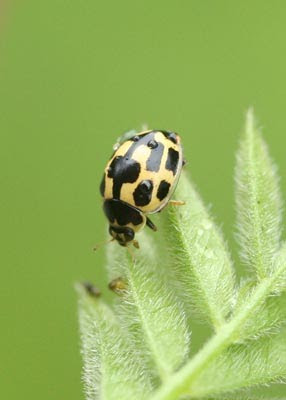The 14-spot ladybird is very often overlooked: it's much smaller than the common 7-spot, being roughly the same size as a match head (and the same size as the 10-spot).

My last blog entry showed Taphrina alni, a fungus that alters the growth pattern of Alder cones. The Taphrina family is quite large and appears on different trees, always distorting leaves or cones in order to increase the spore-bearing surface area. As soon as I saw this curled leaf-edge on Hawthorn, Taphrina came to the front of my mind, and a quick look at the references revealed Taphrina crataegi:
 The fungal season has certainly arrived. I think I'll visit Ards on Sunday. This is the very common Bolbitius vitellinus:
The fungal season has certainly arrived. I think I'll visit Ards on Sunday. This is the very common Bolbitius vitellinus:

This is the time of year to examine the flowers of rushes for the tiny larval cases of the Coleophora micromoths:
 The fungal season has certainly arrived. I think I'll visit Ards on Sunday. This is the very common Bolbitius vitellinus:
The fungal season has certainly arrived. I think I'll visit Ards on Sunday. This is the very common Bolbitius vitellinus:
Staying with fungi, this is the very rare Suillus flavidus which I first recorded for Ireland about 5 years ago. It's a Pine associate, and is never found more than a few metres away from its tree:
 It looks rather like a smaller and paler version of Slippery Jack (which can often be found close to it, since that is also a Pine associate). The two main identification features are the red jelly ring:
It looks rather like a smaller and paler version of Slippery Jack (which can often be found close to it, since that is also a Pine associate). The two main identification features are the red jelly ring:
 And the large angular spore tubes:
And the large angular spore tubes:
 It would be worth checking your Pine trees to see if you can find it.
It would be worth checking your Pine trees to see if you can find it.
 It looks rather like a smaller and paler version of Slippery Jack (which can often be found close to it, since that is also a Pine associate). The two main identification features are the red jelly ring:
It looks rather like a smaller and paler version of Slippery Jack (which can often be found close to it, since that is also a Pine associate). The two main identification features are the red jelly ring: And the large angular spore tubes:
And the large angular spore tubes: It would be worth checking your Pine trees to see if you can find it.
It would be worth checking your Pine trees to see if you can find it.


4 comments:
A fascinating selection. particularly like the ladybird...
Rosy Rustic, what a beautiful name!
You have the naturalist's eye for the unusual Stuart - fascinating pictures and information.
Please tell me, I have a feeling I asked you this last year too, what is the 'pincushion blob of fuzz' on the stem of the wild rose - is it gall wasp? If you don't know what I mean and you have time, please look at the photo on my blog today.
It would be nice to have a herbarium specimen made of the Taphrina crategi infected leaf.
Keep an eye out for Sphaerotheca pannosa a powery mildew on this host.
Post a Comment